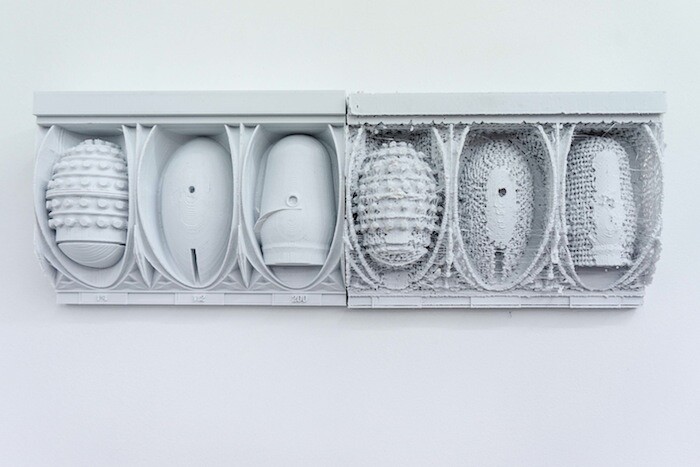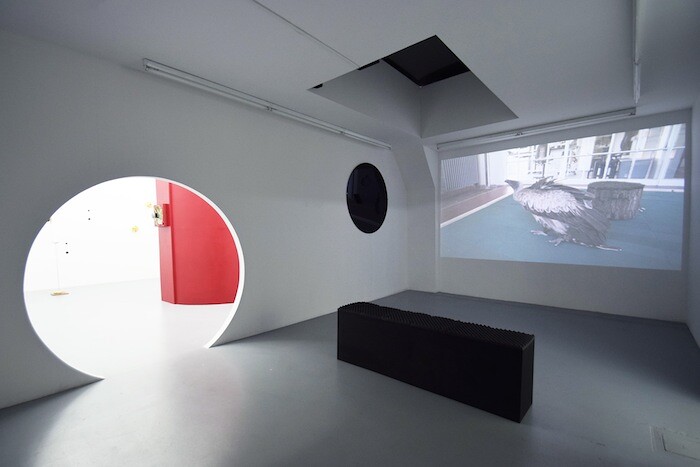The inauguration of the European Parliament building in Brussels was marred by a defect of architectural planning: visitors approaching it were blown over by currents of air inexpertly funneled around the construction. One imagines stacks of European bureaucracy sent into elegant airborne swirls by the gusts of wind. The front of the building was fitted in 2008 with a “comfort ring” that alleviated the wind nuisance, a solution designed and tested at the Von Karman Institute for Fluid Dynamics, a NATO research facility near Brussels.
This was one of the many narrative threads woven by artist Haseeb Ahmed into a performance presented earlier this year at the institute. Ahmed’s exhibition at Harlan Levey Projects realigns the documents, artifacts, and intuitions of that event, with the film The Wind Egg (2016) the most explicit link between these chapters in his research. Footage of the performance is edited into the fictional survey of a regular day’s work at the institute. The audience that followed the performative procession through wind tunnels, the auscultation of their inhuman breath, is now out of sight, and the scientists attend to arcane contraptions, moving between what seem to be an aviary and heavily equipped chambers of impregnation, mythopoeic diagrams, and receptacles for immaterial seeds.
To equal extents a conjuring and a trap, Ahmed’s project—an assemblage of ritualistic and technological operations—engages its singularly elusive object, wind, by intersecting two regimes of aerodynamic imagination. “Wird” couples the 3,000-year-old theory that wind could fertilize animals or humans, as it does plants, with the technological protocols of wind tunnels. “Few scientific errors have had such an honorable history,” writes Conway Zirkle in an essay that reviews the mutations and geographical spread of the belief in wind-propagated parthenogenesis in mares, Amazons, and vultures.1 The exhibition twines this ancestry into modern attempts to domesticate wind in its tutelary image: the cross-species event of a vulture traversing a wind tunnel. This encounter is unpacked as a study of fertility and abstraction, as a kinetics of indexes and signifiers between the two domains.
The vulture’s flutter works as a “cut” between scenes of volatility and transportation, approximating the presence of wind as a figure in and of itself, rather than as unsettled ground for other figures.2 A dark room discloses wind’s sardonic grin, as the empty eyes of two tiny vortexes are illuminated with red lasers. An installation mixes the bird’s mating call and the amplified hiss of airflows, as it pairs the pulsating membrane of loudspeakers and the plaster surface of a mutated ovum, an egg-like architectural model awaiting insemination in a de-gendered future. Casts of decommissioned wind turbine blades, like a fractured wingspan, work as perches for potential aquiline visitants, while variations on the egg-and-dart ornamental motif recast those shapes as a chart of procreative feedback.
The only emblem of virility allowed within the confines of this biopoetics is a double take on Umberto Boccioni’s Unique Forms of Continuity in Space (1913). By photographing casts of the sculpture in Milan and New York, Ahmed accelerates its dynamic stride into an emasculated hyperbole. The results merge the silhouette with a different kind of space and ecstatic speed than those envisioned by Boccioni: a duo of 3D prints re-cast the figure as incorporated dispersal, woven from, rather than posited against, an engulfing abyss.
“Wird” suggests a kind of cosmic, abstract voluptuousness as backdrop for the ghosts it invokes and the cyborgs it assembles. Wind is a metonym of the nothingness that stands beside each endeavor, a sign of its mobility between origin and terminus—a vacant eschatology that equalizes flapping foliage and whorls of dust, pollen, and contaminates, transformation and the clumping of infinite disintegrations, the “more” and the “less.” By contrast, the future that is prefigured in Ahmed’s project, as much as it is wrested from the vestiges of theories and technologies, holds the promise of an abstract fecundity. “Wird” seems to be about desire, its plasticity and its urgency. It envisages fragile intimacies, exposed to and enabled by the wind: in some aberrant, mutant form, these continue to separate and commune, flirt and fuse, flicker as minuscule short-circuits in the otherwise depleted landscapes where pulverized concrete, shed skin, and post-filth accumulate.
Conway Zirkle, “Animals Impregnated by the Wind,” Isis vol 25 no 1 (May 1936): 95-130. Tellingly, Christian theologians did not disprove insemination by wind, as, in a form of complicit acculturation, it lent immediate credibility to the transmission of holy words into virginal wombs.
A relevant precedent for Haseeb Ahmed’s use of wind is his previous work Fish Bone Chapel (2013), which intersects toxico-genomics and the symbolism of ossuaries. Its “medium” is a displaced boundary between life and death: mutations in zebrafish skeletons, chemically induced by researchers looking for the effects of toxins and pollutants on their genome. These fish are the material of choice for such tests because they are not considered animals for the first four days of their lives but rather organic material tout court, held in a kind of ontological inertness by a programmatic legal loophole. The vaults, columns, or funerary décor in Ahmed’s project build on images of the denatured embryos, broken vertebrae, and twisted spines of zebrafish, dying before they are legally born.









